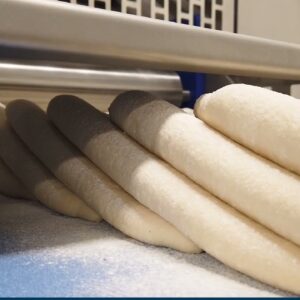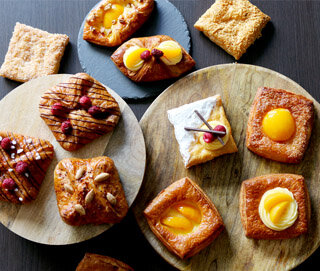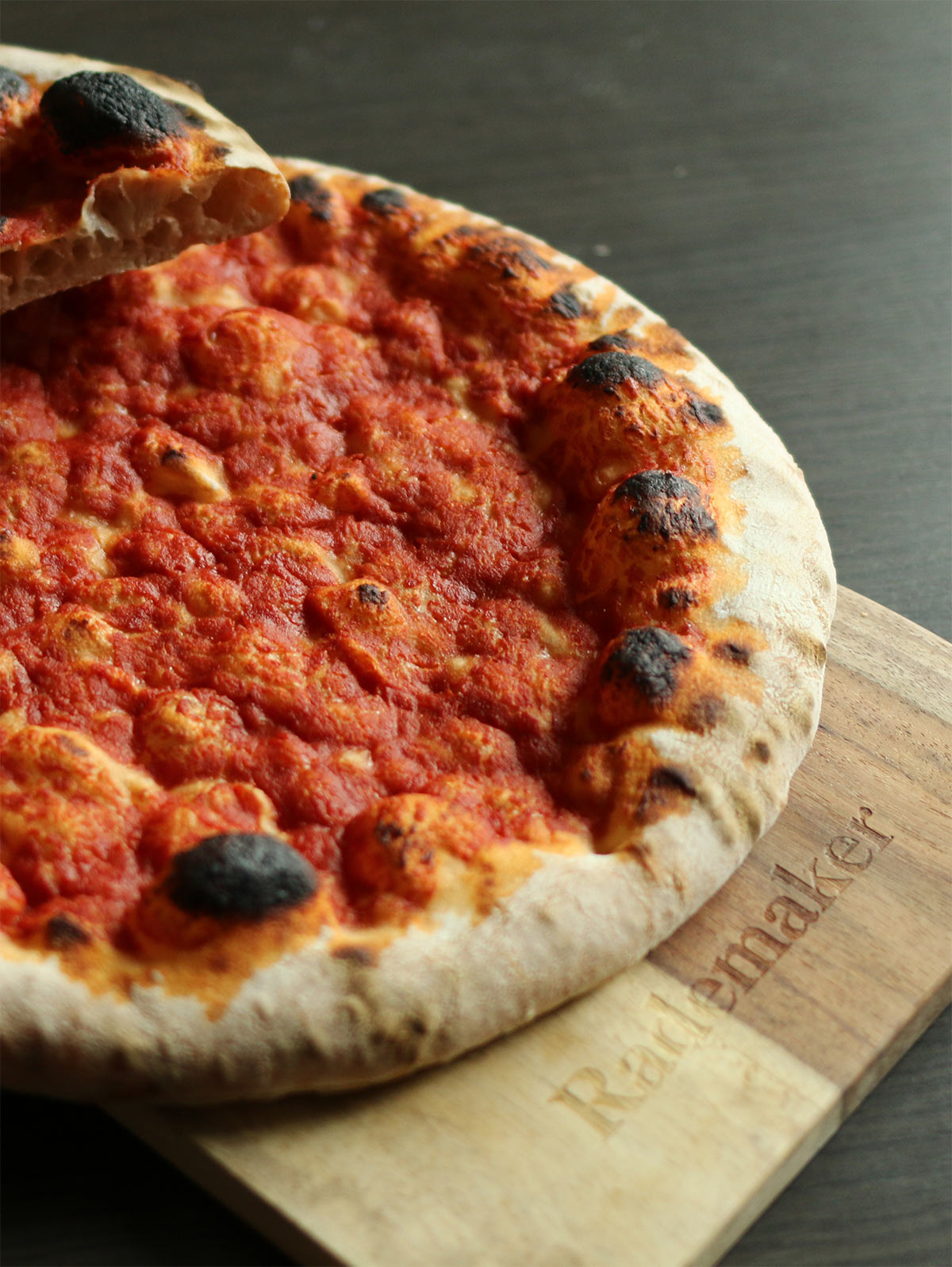Turning Dough into delight
The secret of quality pastry and croissants lies in the laminating process. Precise and consistent layering is key to create the famous light and crispy textures pastries are known for.
With years of experience in pastry production, we design reliable laminating systems that ensure efficient, high-quality output. Whether you’re making croissants, swirls, palmiers, or similar products.
LAYER UP
Laminated
Dough
Basics
The Butter Step
Laminated dough consists of several layers of dough, separated from each other by thin layers of fat, such as margarine or butter.
Read more
Fat is used to soften the dough, add flavour and to create the desired texture. Adding fat can be done in several ways.
The Scottish method
also known as the Dutch-, All-in- or Blitz method. The fat substance is divided into cubes is added to the other ingredients. After mixing/kneading, the dough is formed into a sheet and laminated.
The French method
A dough sheet is produced, then a layer of fat is added to the dough sheet and folded into the dough to form two layers of dough and one layer of fat.

Layered with Purpose
The number of layers in dough depends on the type of product you aim to create. Each dough type has its own lamination requirements to achieve the right texture, volume, and bite.
Read more
For example, yeasted croissant dough typically consists of 16 layers — enough to create that light, airy structure with a delicate crunch on the outside.
Danish pastry, known in German as Plunderteig, is also yeast-raised but often contains a higher fat percentage than croissant dough. A classic example of this type is the Danish Spandauer, which is rich, soft, and buttery.
In contrast, puff pastry (Blätterteig in German) is made from yeast-free dough and requires a much higher number of layers — often 64 to 100 when produced on an industrial laminator. This creates a fine, crisp structure with thinner layers and less volume per fold. A well-known product in this category is the mille-feuille, which literally means ‘a thousand sheets’.

Steam & Structure
A crispy structure forms during baking as water in the dough turns to steam, causing the layers to expand. The steam lifts and separates the laminated layers, creating a light, flaky texture with a delicate crunch.
Read more
With the right technique, you can produce a wide range of pastries and croissants effortlessly. Use many thin layers to create a refined puff pastry with a crisp, delicate bite. Or opt for fewer layers combined with yeast to achieve an open, airy structure — perfect for croissants with a tender interior and golden crust.
Whether you’re targeting a crisp bite or a soft, layered crumb, precision lamination is key. The number of folds, the fat content, and the dough type all work together to shape the final product.

Texture and Taste
The number of layers created during the laminating process has a direct impact on the final texture and taste of the baked product.
Fewer layers result in a more open, airy structure. More layers, on the other hand, create a finer, crispier texture with thinner separation between each sheet

Has our layering sparked your curiosity?
Our Laminators
We offer two different laminating systems. For more information on the processes, check the Rademaker or Radini Laminator pages, or get in touch with your regional sales agent.

Radini
— Compact
- From 250 kg to 1,000 kg of dough per hour
- Up to 8 layers per section
- Working width:600 or 800 mm
- No risk of fat extraction

- From 500 kg to 10,000 kg of dough per hour
- Up to 512 layers
- Working width:600, 800, 1,000 & 1,200 mm
- Optional: working width greater than >1,200
Manual or automated
From Sheet to Shape
After the lamination process, the dough can either be cut into blocks or processed into a continuous sheet, depending on the desired production method.
For a fully automated workflow, a Universal Pastry Make-up Line can be added for an automated process to shape, fill, and decorate products with high efficiency and consistency.
Alternatively, manual handling allows for greater flexibility and artisan finishing, ideal for bakeries that value craftsmanship and variety in their product range.



Quality Commitment
OUR Product
Range
Our solutions are designed with one clear principle: preserving dough quality from start to finish.
Thanks to our innovative stress-free production technology, the integrity developed during mixing is maintained throughout the entire process. The result is reliable performance and consistent end products that meet the highest standards every time.
Laminated Dough
Pastry
Croissant
Savory & Sweet Pies
Bread & Buns
Flatbread
Pizza
Pinsa
Donut
Gluten-Free
Long Shelf-Life
We design reliable laminating systems that ensure efficient, high-quality laminated dough output. Whether you’re making croissants, swirls, palmiers, or similar products.
Classic or innovative, pure or filled with premium chocolate or fruit preserves, pastry comes in all shapes and sizes to meet diverse consumer tastes. Yeast or puff pastry, with butter or plant-based fats like margarine, our Universal Make-up Line delivers your product exactly as you envision it
Our croissant lines work with all types of croissant dough. From classic to gluten-free and long-shelf-life dough. This allows us to create a wide variety of products while ensuring the taste, texture, shape, and consistency you and your customers expect.
From sweet fruit pies to savory quiches and pastel de nata, our lines can produce it all. With versatile depositors, we create open or closed-top pies in foils or on trays. Whatever the variety, We ensure the quality and flexibility you need.
Soft tin breads with a fine crumb, crusty artisan loaves with an open structure, or gluten-free and bio varieties: bread is a timeless favorite. Every recipe brings unique flavors and textures to the table. Whatever bread you wish to create, our dough processing capabilities make it possible, because bread is endlessly versatile, and so is our line.
Flatbreads have been enjoyed for centuries and recently gained worldwide popularity thanks to their healthy image. Pita, naan or tortillas each bring their own taste and tradition, making flatbread a perfect fit for today’s modern healthy diet. Our Flatbread Sheeting Line makes it possible to create these authentic classics in any shape or size.
Pizza has become a global favorite, enjoyed in endless varieties. Starting with classic bases to richly topped creations. Each style, thin and crispy or soft and airy, offers its own taste and texture, making pizza a perfect match for every occasion. To meet this demand, our Pizza lines makes it possible to produce authentic pizza bases and complete pizzas in any shape or size.
Pinsa is an ancient Roman delicacy that has recently captured the attention of pizza and bread lovers worldwide. Known for its crispy crust, airy texture and natural ingredients, it combines tradition with modern taste. With our Pinsa solution, this authentic specialty can now be produced consistently and at scale
Donuts are a true classic, loved for their soft bite and endless variety of shapes and flavors. Tasty ring donuts or filled creations, cinnamon rolls and honeybuns: each treat brings its own indulgence. To make them all, our Donut Line offers the flexibility to create authentic favorites with consistent quality and taste
The gluten-free lifestyle created new challenges for bakeries as gluten-free dough requires unique expertise due to its sticky and delicate nature. Our proven technology and experience ensure reliable, high-quality gluten-free production.
As demand for long shelf-life croissants and pastries grows, bakeries need solutions that combine innovation with tradition. By using a rich recipe with sourdough and a specialized enzyme blend, Rademaker’s proven technology ensures soft, high-quality products that stay fresh longer
Contact Us
Ready to automate your production? Learn more and get in touch by phone, email, or by using our contact form










